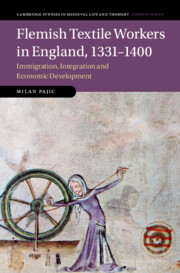Book contents
- Flemish Textile Workers in England, 1331–1400
- Cambridge Studies in Medieval Life and Thought Fourth Series
- Flemish Textile Workers in England, 1331–1400
- Copyright page
- Contents
- Figures
- Maps
- Tables
- Acknowledgements
- Note on Currency, Weights and Measures
- Abbreviations
- Introduction
- Chapter 1 Anglo-Flemish Economic Relations, Complex Urban Revolts and the Politics of Collective Exile in Flanders
- Chapter 2 Flemish and Brabantine Immigrants as Permanent Residents in England 1351–1400
- Chapter 3 Social Relationships and Business Networks of the Flemish Community in England
- Chapter 4 Economic Activities of the Immigrants from the Low Countries: Wool and Woollen Cloth Production and Trade
- Chapter 5 Women from the Low Countries in England and Their Economic Activities
- Chapter 6 Anti-Fleming Sentiment and the Peasants’ Revolt of 1381
- Conclusion
- Book part
- Select Bibliography
- Index
Chapter 2 - Flemish and Brabantine Immigrants as Permanent Residents in England 1351–1400
Published online by Cambridge University Press: 16 November 2023
- Flemish Textile Workers in England, 1331–1400
- Cambridge Studies in Medieval Life and Thought Fourth Series
- Flemish Textile Workers in England, 1331–1400
- Copyright page
- Contents
- Figures
- Maps
- Tables
- Acknowledgements
- Note on Currency, Weights and Measures
- Abbreviations
- Introduction
- Chapter 1 Anglo-Flemish Economic Relations, Complex Urban Revolts and the Politics of Collective Exile in Flanders
- Chapter 2 Flemish and Brabantine Immigrants as Permanent Residents in England 1351–1400
- Chapter 3 Social Relationships and Business Networks of the Flemish Community in England
- Chapter 4 Economic Activities of the Immigrants from the Low Countries: Wool and Woollen Cloth Production and Trade
- Chapter 5 Women from the Low Countries in England and Their Economic Activities
- Chapter 6 Anti-Fleming Sentiment and the Peasants’ Revolt of 1381
- Conclusion
- Book part
- Select Bibliography
- Index
Summary
Once the immigrants crossed the English Channel, new challenges appeared for all of them, whether they were economic migrants or exiles. These issues ranged from the legal situation and the choice of town for permanent settlement, to finding a residence and employment opportunities, which all represent the basis for a healthy start to life in a new place. The purpose of this chapter will therefore be to present the profile, the numbers and the occupations of the immigrants, and to identify those parts of the towns in which they took up residence. The main focus will be on those who were exiled from Flanders after the rebellion and on Flemish textile workers as identified from the sources on the other side of the English Channel. The chapter will start with the fortunes of Flemish immigrants in the English capital, then continue with the market town of Colchester, situated on the east coast, in the county of Essex, to finally turn attention to Great Yarmouth, the port town of the county of Norfolk. In order to reinforce my overall argument, the Flemish and Brabantine presence will be discussed in other towns throughout England.
- Type
- Chapter
- Information
- Flemish Textile Workers in England, 1331–1400Immigration, Integration and Economic Development, pp. 66 - 130Publisher: Cambridge University PressPrint publication year: 2023

